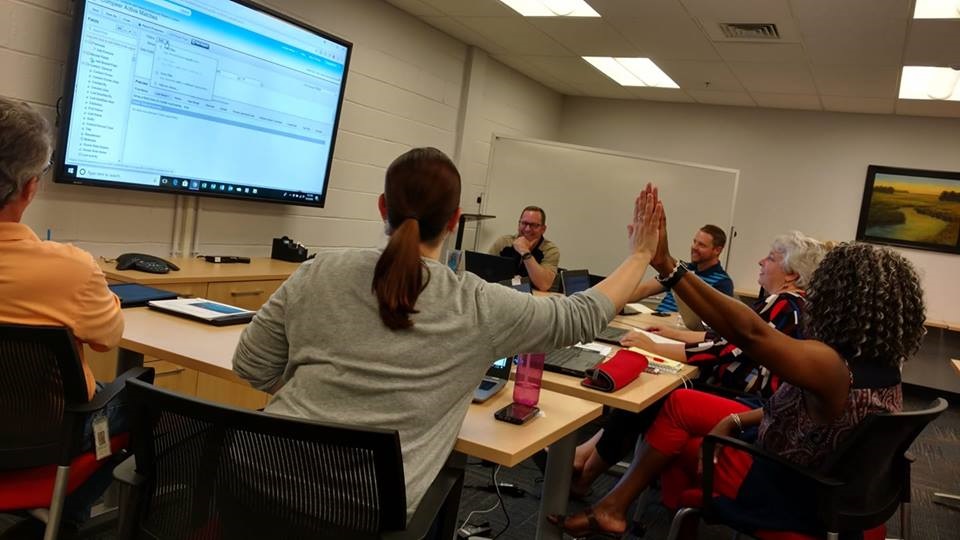 Special to the Philanthropy Journal
Special to the Philanthropy Journal
By Kimberly Lanphear
How does an organization driven by passionate minds with knowledge in lifting those in need, serving those with less, and pivoting policies toward human independent sustainability, engage with exponentially changing technology and business processes? How does a nonprofit enlist efficiency improvements and best practices technology processes without funders or donors who understand technology innovation or recognize the need for updated infrastructure and processes to serve effectively?
 Apparo is a Charlotte, NC nonprofit that transforms the community and improves lives by connecting local nonprofits to technology expertise and resources that amplify their impact. We provide skilled technology volunteer partnerships with nonprofits that create a multiplier effect of value in the community, serving more than 450 nonprofits in the greater Charlotte market, 125+ each year. Our services include technology training at the individual nonprofit employee level, the nonprofit level, and for collaborative groups of nonprofits with varying missions. We also provide Community Impact Projects – teams of skilled IT, consulting and/or business professionals who work to provide sustainable, process improving technology-related solutions for nonprofits. The third pillar of our offerings is Tech Therapy, a service delivered by Apparo staff at no cost, providing advice and guidance regarding technology of all kinds, and referrals to vetted service providers who have a philanthropic approach and pricing.
Apparo is a Charlotte, NC nonprofit that transforms the community and improves lives by connecting local nonprofits to technology expertise and resources that amplify their impact. We provide skilled technology volunteer partnerships with nonprofits that create a multiplier effect of value in the community, serving more than 450 nonprofits in the greater Charlotte market, 125+ each year. Our services include technology training at the individual nonprofit employee level, the nonprofit level, and for collaborative groups of nonprofits with varying missions. We also provide Community Impact Projects – teams of skilled IT, consulting and/or business professionals who work to provide sustainable, process improving technology-related solutions for nonprofits. The third pillar of our offerings is Tech Therapy, a service delivered by Apparo staff at no cost, providing advice and guidance regarding technology of all kinds, and referrals to vetted service providers who have a philanthropic approach and pricing.
Apparo utilized (and still utilizes) a business method called Design Thinking (DT) to build our current business model which is now a force-multiplier in the community; a multiplier of funding, skills and passion. We now are able to leverage each dollar donated to Apparo to generate more than $1.67 of value to our community’s nonprofits. We have multiplied the number of nonprofits we serve in a year by 300%, from 40 /year to 125+/year.
To define it simply, DT is the process of identifying a need, proposing a solution, then implementing that solution on an extremely small scale, a pilot, followed by measurement, group assessment and program adjustment so that another phase of piloting can occur. This is repeated until a fully-formed program is running. Understand from the outset, DT adds no cost, it empowers employees, it engages nonprofit employees in challenges that enhance their career experience (employee retention!) and improves outcomes.
DT is a business methodology that promotes failing fast and failing forward. It encourages flexibility of program process, iteration of program offerings and agility of organizational behavior. DT is a way of managing service offerings that provides great opportunities for nonprofits to:
- Offer new and exciting challenges that will keep employees engaged and empowered
- Lower costs of program innovation
- Create programs and program adjustments that are sustainable and measureable
The design of one of Apparo’s programs in particular, exemplifies the impact of using DT to improve service offerings for nonprofits – our Community Impact Projects.
 Apparo piloted engaging skilled IT volunteers to provide sustainable technology and business process solutions 6+ years ago with three partnerships. In full DT form, we tested different funding models and engagement parameters for each of the three. Apparo staff stayed closely involved in each partnership, tracking the processes, looking for problems and areas for improvement. We surveyed the participants along the way and at the conclusion. We reported out to all parties involved and garnered further input. We then strategized with our Board of Directors, who brought their vast business acumen and skills to further fine-tune the program.
Apparo piloted engaging skilled IT volunteers to provide sustainable technology and business process solutions 6+ years ago with three partnerships. In full DT form, we tested different funding models and engagement parameters for each of the three. Apparo staff stayed closely involved in each partnership, tracking the processes, looking for problems and areas for improvement. We surveyed the participants along the way and at the conclusion. We reported out to all parties involved and garnered further input. We then strategized with our Board of Directors, who brought their vast business acumen and skills to further fine-tune the program.
We learned that it our facilitation of these projects that has ensured the sustainability and appropriateness of the solutions designed. Our nonprofit partners are able to engage with technology in ways that had previously been unimaginable by them.
The metrics applied during our iterative DT build of our programs demonstrate that our programs assist nonprofits to better understand and articulate the impact of their programs because of improved data access and staff knowledge. Some participant nonprofits indicate that as much as the value of one or one-and-a-half full-time employees can be made available for mission-specific work versus administrative work at a project’s conclusion.
Nonprofits have the challenge of funding innovation and/or improved efficiency infrastructure because most funders have interest in funding only programs that can be shown to have direct and measureable impact on the service beneficiary. There is no pay-to-play for service users, no market driver to create more accessible or innovative platforms; just drivers for program results at the lowest costs possible. Conversely, profit driven organizations are incented to innovate and improve efficiencies by consumers paying for quality, ever-changing product lines and, as a result, shareholder profit grows.
 As organizations that are frequently led by passion driven professionals who chose their careers driven by personal desires to improve the world, nonprofits’ leadership skills are not always business efficiency focused. There is often little possibility of market-level pay or resources from which to ensure the highest quality, effective programming. In this environment, it becomes imperative that nonprofit leaders lean into the DT approach.
As organizations that are frequently led by passion driven professionals who chose their careers driven by personal desires to improve the world, nonprofits’ leadership skills are not always business efficiency focused. There is often little possibility of market-level pay or resources from which to ensure the highest quality, effective programming. In this environment, it becomes imperative that nonprofit leaders lean into the DT approach.
In order to gain the benefits of this approach, nonprofits need to create a culture of openness to learning from failures, of even encouraging failures when they can provide information for improvement. For this culture to be effective, it must be coupled with flexibility and empowerment of the employee. When you empower employees to adjust and own the results, giving them confidence that a failure will not mean sudden death, you give the organization the ability to iterate and improve.
This iterative, flexible approach is practiced throughout Apparo. We work to provide clarity while not imposing rigidity. We get excited about new ideas and find that the DT approach allows us to evolve to places that we had not initially envisioned; our ideas improve beyond their conceptual form. This flexibility allows us to be adaptive and additive, which ultimately creates higher value to our partners.
Along the path of our iterative approaches, we recognize the importance of individual ownership. Employees are held accountable for the program in order to have a point from which to navigate the tensions that are inevitable during creative processes with groups. There is also the need for purposeful investment in organizational behavior and focus. As individual empowerment is granted, teams need to be self-aware of their individual leadership roles and committed to team achievement and work fulfillment. This takes a great deal of leadership time and energy.
Nonprofits are, by their very nature, required to be creative in their efficiency and operational approaches. DT is a strong tool to enable this at little cost. It requires that leadership empower employees, allow for failure and spend time building team individual trust and leadership skills. DT requires a strong commitment to flexibility and iterative programmatic adjustments and building. Along the way, DT creates incredibly rewarding work environments that focus employees on the mission results and help the organization avoid the pitfalls of chasing funding that may take the eye off the mission goals.
Kim Lanphear is the CEO of Apparo, a nonprofit connecting local nonprofits to technology expertise & resources that amplify their impact in the community. Recognized for her skills in change management and cultural leadership, Kim has led Apparo to focus on achieving solution sustainability for nonprofits and a leverage of $1.60+ of community value for every dollar donated.





